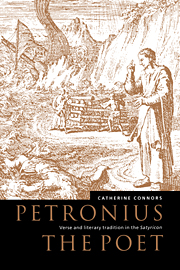Book contents
- Frontmatter
- Contents
- Prefatory note
- Acknowledgements
- List of abbreviations
- Introduction
- 1 Refashioning the epic past
- 2 In the frame: context and continuity in the short poems
- 3 Troy retaken: repetition and re-enactment in the Troiae Halosis
- 4 The Bellum Civile
- Epilogue
- Bibliography
- Index of passages discussed
- Index of subjects
3 - Troy retaken: repetition and re-enactment in the Troiae Halosis
Published online by Cambridge University Press: 28 October 2009
- Frontmatter
- Contents
- Prefatory note
- Acknowledgements
- List of abbreviations
- Introduction
- 1 Refashioning the epic past
- 2 In the frame: context and continuity in the short poems
- 3 Troy retaken: repetition and re-enactment in the Troiae Halosis
- 4 The Bellum Civile
- Epilogue
- Bibliography
- Index of passages discussed
- Index of subjects
Summary
Ancient fictional picture galleries are hothouses of meaning: in their confined, lushly descriptive atmosphere, ecphrasis runs riot, intensifying the themes and obsessions of the novel at large. In Petronius' picture gallery, Encolpius and Eumolpus reveal their preoccupations and concerns when they put art into words.
It is not clear why Encolpius goes to the gallery, whether he has just had a narrow escape, or has wandered in by accident, or deliberately come to look at art – though he is clearly upset at losing Giton. He first marvels at the realistic qualities of works attributed to the ancient masters Zeuxis, Protogenes, and Apelles. Then he considers paintings of the myths of Ganymede carried off by Jupiter, Hylas, and the nymph, and Apollo and Hyacinthus. Encolpius' reaction to these paintings distorts the more usual interpretations of the myths depicted (83.4–5):
ergo amor etiam deos tangit. Iuppiter in caelo suo non invenit quod eligeret, et peccaturus in terris nemini tamen iniuriam fecit. Hylan Nympha praedata imperasset amori suo, si venturum ad interdictum Herculem credidisset. Apollo pueri umbram revocavit in florem, et omnes fabulae quoque habuerunt sine aemulo complexus.
So love touches even the gods. Jupiter in his heaven did not find anything to love and so headed to earth for debauchery, yet he harmed no one. The nymph who caught Hylas would have held her passion in check if she had believed that Hercules would come to contest her claim.
- Type
- Chapter
- Information
- Petronius the PoetVerse and Literary Tradition in the Satyricon, pp. 84 - 99Publisher: Cambridge University PressPrint publication year: 1998

